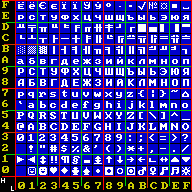Related Research Articles

Code page 866 is a code page used under DOS and OS/2 in Russia to write Cyrillic script. It is based on the "alternative code page" developed in 1984 in IHNA AS USSR and published in 1986 by a research group at the Academy of Science of the USSR. The code page was widely used during the DOS era because it preserves all of the pseudographic symbols of code page 437 and maintains alphabetic order of Cyrillic letters. Initially this encoding was only available in the Russian version of MS-DOS 4.01 (1990), but with MS-DOS 6.22 it became available in any language version.
Mac OS Cyrillic is a character encoding used on Apple Macintosh computers to represent texts in the Cyrillic script.
Mac OS Central European is a character encoding used on Apple Macintosh computers to represent texts in Central European and Southeastern European languages that use the Latin script. This encoding is also known as Code Page 10029. IBM assigns code page/CCSID 1282 to this encoding. This codepage contains diacritical letters that ISO 8859-2 does not have, and vice versa.
Code page 869 is a code page used under DOS to write Greek and may also be used to get Greek letters for other uses such as math. It is also called DOS Greek 2. It was designed to include all characters from ISO 8859-7.
Code page 861 is a code page used under DOS in Iceland to write the Icelandic language.
Code page 862 is a code page used under DOS in Israel for Hebrew.
Code page 775 is a code page used under DOS to write the Estonian, Lithuanian and Latvian languages. In Lithuania, this code page is standardised as LST 1590-1, alongside the related Code page 778.
Code page 773 is a code page used under DOS to write the Estonian, Lithuanian and Latvian languages.
Code page 912 is a code page used under IBM AIX and DOS to write the Albanian, Bosnian, Croatian, Czech, English, German, Hungarian, Polish, Romanian, Serbian, Slovak, and Slovene languages. It is an extension of ISO/IEC 8859-2, though prior to 1999, the code page matched ISO/IEC 8859-2 exactly.
Code page 915 is a code page used under IBM AIX and DOS to write the Bulgarian, Belarusian, Russian, Serbian and Macedonian but was never widely used. It would also have been usable for Ukrainian in the Soviet Union from 1933 to 1990, but it is missing the Ukrainian letter ge, ґ, which is required in Ukrainian orthography before and since, and during that period outside Soviet Ukraine. As a result, IBM created Code page 1124. It is an extension of ISO/IEC 8859-5. The original code page matched ISO/IEC 8859-5 directly.
Code page 770 is a code page used under DOS to write the Estonian, Lithuanian and Latvian languages. It is a variant of code page 775 which does not cover the Polish language, but moves the remaining characters in a way that it retains all box-drawing and mathematical symbols from code page 437.
Code page 1118 is a code page used under DOS to write the Lithuanian language. It was previously standardised in Lithuania as LST 1283.
Code page 1117 is a code page used under DOS to write the Estonian, Lithuanian and Latvian languages. It is closely related to both code page 773 and code page 775.
Mac OS Romanian is a character encoding used on Apple Macintosh computers to represent the Romanian language. It is a derivative of Mac OS Roman.
Code page 921 is a code page used under IBM AIX and DOS to write the Estonian, Latvian, and Lithuanian languages. It is an extension of ISO/IEC 8859-13. The original code page matched ISO/IEC 8859-13 directly.
Code page 777 is a code page used under DOS to write the Lithuanian language. It is a modification of Code page 773 to support the accented Lithuanian letters and phonetic symbols for Lithuanian.
Code page 778 is a code page used under DOS to write the Lithuanian language. It is a modification of code page 775 to support the accented Lithuanian letters and phonetic symbols for Lithuanian. This code page is also known as LST 1590-2.
LST 1564:2000 is a character encoding used to write the Lithuanian language. It is a modification of ISO/IEC 8859-13 to support the accented Lithuanian letters.
LST 1590-4 is a character encoding used to write the Lithuanian language. It is a modification of Windows-1257 to support additional accented letters and phonetic notation. This is called Code page 58601 by FreeDOS.
References
- ↑ Aivosto. "Codepages: Comprehensive list". aivosto.com. Retrieved 2019-08-28.
- ↑ "Image: 776.png, (1772 × 2362 px)". xn--lietuvyb-ceb.lt. Retrieved 2019-08-28.